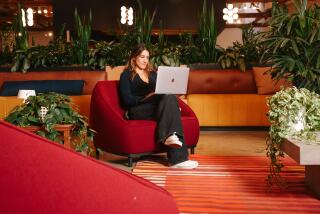Home Office: A Study in Style
- Share via
They used to be called studies, and, oh, were they wonderful. Ward Cleaver had one. So did Robert Young and Fred MacMurray. Winston Churchill practically lived in his at Chartwell, and wrote there while standing up.
Even the name of the room implied something. “He’s in the study,” used to mean that the head of the house was either hip deep in old books (and loving it), or had his feet crossed on the desktop, a fragrant Havana cradled in his fingers, and was lounging blissfully in a Sulka smoking jacket, puffing little blue rings at the ceiling and pondering.
No more. There are precious few real studies anymore because there are precious few people today who go in for the sort of leisurely bookishness and serendipitous meditation that a good study requires. And just try lighting a cigar indoors anymore; you’ll be lucky to get off with the death penalty.
No, the study of the ‘90s is known as the home office, and people go there to do work and pay bills. It is, therefore, a kind of torture chamber. It has a personal computer, a phone and perhaps a copier and fax machine. Information wings in and out of there like so many flaming arrows. Money changes hands as fast as envelopes can be licked. Ledgers are filled, I’s are dotted, T’s crossed. It’s hell.
But even hell deserves a nod to good design. And while it may not be possible to reproduce the ambience of the traditional Masterpiece Theatre-like study (especially while the fax is whirring and the PC is beeping and the answering machine is telling callers you’re not there), you can at least make yourself more comfortable while you’re suffering.
One enduring rule of home office assembly, said Germaine Peiffer, a designer with Hansen Design Associates in Santa Ana who specializes in space management, is to take your cue from a page from Monty Python and don’t get a comfy chair. The Pythons used one in their Spanish Inquisition sketch as a torture device, and it will do the same for you over time. Forget the plush, cushy executive-style thrones. If you’re going to spend any kind of continuous time in your office, you want support.
“You want your back to feel good at the end of the day,” Peiffer said. “Sometimes it’s hard for Americans to look at European ergonomically designed chairs because we’re used to cushy comfort.”
Having decided on the spot you’ll park your body during working hours, you’ll want to turn your attention to the mental side of things. Try to establish your office somewhere away from the traffic.
“Make every possible arrangement in the household to keep the daily distractions down to a minimum--family, animals or whatever,” Peiffer said. “A lot of people find they can’t work at home because of distractions.”
A window, however, can help, she said, as can a stimulating color on the walls.
“It’s a good idea to give the walls a lift,” she said. “Get something on the walls, perhaps a color other than something neutral, something you’re really happy with.”
Also, said Peiffer, “hang something pleasing to the eye or something serviceable on the walls. I’ve always found world maps mesmerizing. You can always sit back and look at them, and you’re always noticing something new. Or get a framed piece of artwork, something that you really love, something that calms or stimulates you.”
As for office machines and storage--a computer, phone, answering machine, fax, copier--get what you need, but make sure it’ll fit. The size of many office machines, said Peiffer, is becoming more standardized, but what looks appealing in the store may grow to unmanageable size once it’s in the confines of your office. Measure everything before buying. And if you need a lot of desktop hardware, it might be a good idea--if you have space--to buy a U-shaped desk.
“I would then think of the person as an island,” Peiffer said. “You want to work all of your equipment around you so you have the minimum amount of getting up and walking to do something. Put everything within reaching distance as much as possible.”
If you’re short, this includes the desktop. This is no joke. Desks, said Peiffer, “are designed to sit about 90% of the population in terms of their height. There is a standard height.”
If you’re short, this means raising yourself higher in your chair--which usually is easy since most office-style chairs have mechanisms to do just that. However, this may also raise your feet off the floor, making sitting for even a short time uncomfortable. You can chain-saw the entire desk down a notch, but a more economical and aesthetic answer, said Peiffer, is a footrest.
Or, if you’re bucking for British prime minister and savior of the Western world, you can do your work standing up. But then you’d need the smoking jacket and the cigars and maybe an occasional brandy and a bunch of musty old books and perhaps a golden retriever to sit at your feet. And then your meticulously planned office of the ‘90s would metamorphose into a study, and instead of marketing proposals you’d start cranking out sonnets. And you’d be in serious danger of having a good time, which is not what an office is for.
On second thought, go ahead and get the comfy chair.






